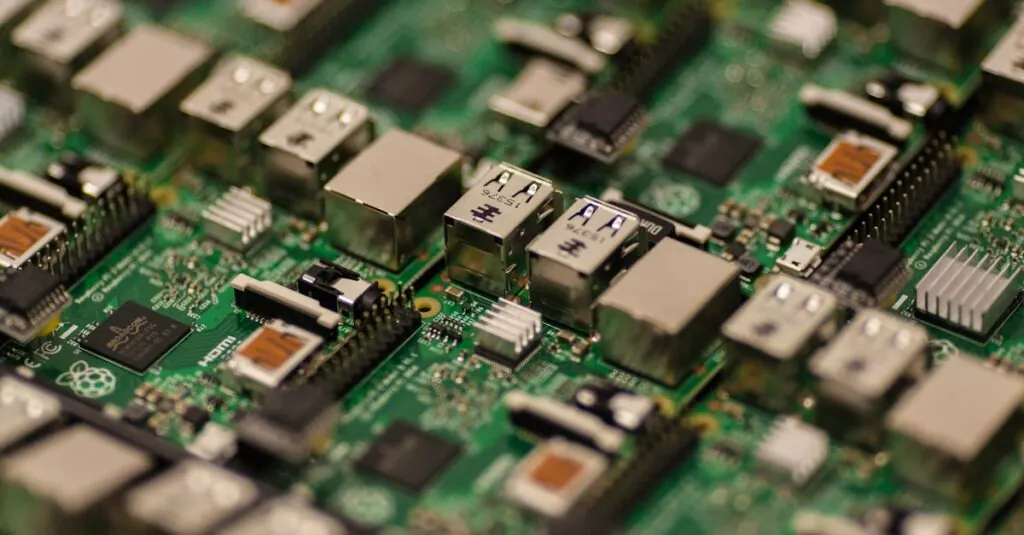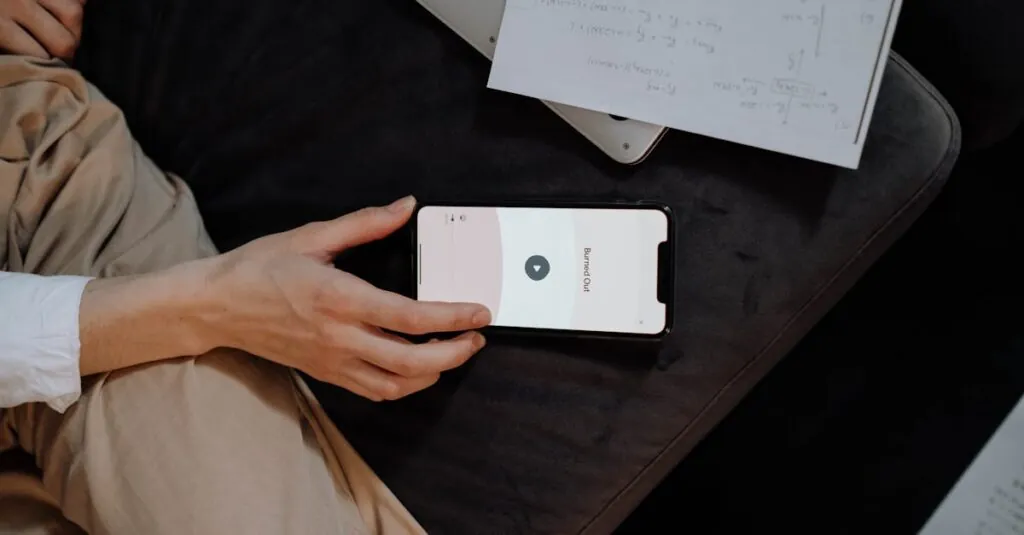Table of Contents
ToggleIn a world where technology seems to have a mind of its own, wearable hardware devices have emerged as the stylish sidekick everyone didn’t know they needed. From fitness trackers that double as motivational coaches to smartwatches that can practically read your mind (well, almost), these gadgets are reshaping how people interact with their health and daily lives.
Imagine strapping on a device that not only tracks your steps but also reminds you to breathe—talk about multitasking! Whether it’s monitoring heart rates during a workout or sending an alert when you’ve been sitting too long, these devices are like having a personal assistant on your wrist. As they become more sophisticated and trendy, it’s clear that wearable tech isn’t just a passing fad; it’s the future of personal wellness and connectivity. Embrace the revolution and discover how these nifty gadgets can elevate everyday living.
Overview of Wearable Hardware Devices
Wearable hardware devices encompass a broad range of products designed to improve personal health and connectivity. These gadgets include fitness trackers, smartwatches, augmented reality glasses, and smart clothing. Fitness trackers, for example, monitor health metrics such as daily steps, heart rate, and sleep patterns. Smartwatches offer much more than timekeeping; they deliver notifications, reminders, and access to apps, enhancing user convenience.
Advanced features mark the latest generation of wearable devices. Many incorporate sensors that provide real-time data analytics. These insights enable users to make informed decisions about their well-being. Increasingly, smartwatches now support mobile payments, GPS navigation, and health monitoring, making them versatile tools for daily life.
Style plays a significant role in the popularity of wearable technology. Manufacturers prioritize aesthetics alongside functionality, leading to fashionable designs that appeal to various demographics. For instance, fitness enthusiasts might prefer sleek, sporty designs, while professionals often opt for devices that resemble traditional watches.
Wearable hardware devices also foster a sense of community among users. Many platforms allow individuals to share fitness achievements, creating motivation through social interaction. Networking options amplify user engagement and encourage consistency in health and fitness goals.
Data security remains a crucial aspect of wearable technology. With the growing amount of personal information collected by these devices, users require reassurance regarding data protection. Manufacturers should implement robust encryption and privacy policies to build user trust.
Wearable hardware devices significantly impact personal well-being and connectivity. Their evolving features and stylish designs position them as integral components of modern life.
Types of Wearable Hardware Devices
Wearable hardware devices come in various forms, each designed to enhance personal wellness or connectivity in unique ways.
Smartwatches
Smartwatches serve as multifunctional devices, combining fitness tracking with smartphone capabilities. Users can access notifications, manage apps, and monitor health metrics like heart rate and sleep patterns. Many smartwatches also feature GPS integration, offering tracking for outdoor activities. Compatibility with mobile payment systems enables convenient transactions, turning these devices into versatile companions. Stylish designs appeal to a wide audience, allowing users to express personal style while benefiting from technology.
Fitness Trackers
Fitness trackers excel in monitoring physical activity and health statistics. They typically measure steps taken, calories burned, and distance traveled, providing comprehensive insights into lifestyle habits. Most models include features like heart rate monitoring and sleep analysis, allowing users to evaluate overall health. Data syncing with mobile applications presents users with detailed reports on their fitness progress. Lightweight and durable, fitness trackers cater to various activities and can often withstand differing environmental conditions.
Augmented Reality Glasses
Augmented reality glasses introduce immersive experiences by blending digital content with the real world. Users can access information hands-free, enhancing engagement with their surroundings. These devices often support applications in gaming, education, and navigation, bringing information to life in real time. Built-in cameras and sensors enable interactive features, creating a dynamic user experience. Designed for comfort and style, augmented reality glasses aim to attract tech enthusiasts as well as professionals seeking efficiency.
Key Features and Technologies
Wearable hardware devices incorporate various features and technologies that enhance user experience and functionality.
Sensors and Data Tracking
Sensors play a crucial role in capturing health-related metrics. Heart rate monitors track cardiovascular health while accelerometers record physical activity levels. Gyroscopes enhance motion detection, providing insights into users’ movement patterns. Advanced sensors collect sleep data and stress indicators, allowing users to gain deeper insights into their health. Accurate data tracking enables users to set and achieve fitness goals effectively.
Connectivity Options
Connectivity options expand the functionality of wearable devices. Bluetooth remains the most common method for pairing devices with smartphones and other devices. Wi-Fi connections facilitate data syncing and enable internet access for app functionality. Some wearable devices now support 4G LTE, offering independent connectivity without relying on smartphones. This versatility in connectivity enhances user convenience and ensures real-time data access and notifications.
Benefits of Wearable Hardware Devices
Wearable hardware devices provide numerous advantages that enhance personal health and daily life. These benefits include health monitoring and increased convenience.
Health Monitoring
Health monitoring stands out as one of the primary benefits of wearable devices. These gadgets track vital metrics such as heart rate, sleep patterns, and physical activity. Users can gain insights into their health efficiently. Real-time alerts notify users of irregularities, promoting prompt action if needed. Wearable devices often integrate advanced sensors, enabling accurate data collection. By continuously monitoring users’ well-being, these tools encourage healthier lifestyle choices and proactive health management.
Convenience and Accessibility
Convenience and accessibility characterize wearable hardware devices. Many wearables sync seamlessly with smartphones, providing easy access to notifications and apps without needing to reach for a phone. Users enjoy hands-free interaction with voice commands and touch features. Wearable devices enable on-the-go functionality, allowing quick responses while driving or exercising. Furthermore, smartwatches and fitness trackers encourage fitness enthusiasts to track their workouts and activities effortlessly. With wearable technology, staying connected and organized becomes simpler than ever.
Challenges and Limitations
Wearable hardware devices face several challenges and limitations that impact user experience and adoption.
Privacy Concerns
Privacy concerns dominate discussions surrounding wearable technology. Users fear that personal health data could be exploited by third parties or inadequately protected. Data breaches can lead to serious consequences for individuals, including identity theft or unauthorized access to sensitive information. Manufacturers must implement stringent security measures and transparent data policies to alleviate these concerns. Users often seek clarity on how their data is collected, stored, and shared with other entities. Trust is significant for user retention; thus, companies prioritizing robust privacy protections gain a competitive advantage.
Battery Life Issues
Battery life issues frequently hinder the functionality of wearable devices. Many gadgets only operate for a limited duration before requiring a recharge. Users find it frustrating when devices cannot sustain usage throughout the day, impacting their experience. Innovations in battery technology could lead to longer-lasting power sources, but improvements are necessary. Some manufacturers utilize energy-efficient components to help extend battery life. Consequently, devices that effectively manage power consumption become increasingly popular among consumers.
Conclusion
Wearable hardware devices are redefining how individuals approach health and connectivity. As technology advances these gadgets are becoming more integrated into daily life. The blend of functionality and style ensures they appeal to a wide audience.
With features like real-time data analytics and mobile payment options wearables offer convenience that enhances user experience. However challenges such as privacy concerns and battery life need addressing to maximize their potential.
The future of wearable technology looks promising as innovations continue to emerge. These devices are not just tools; they’re companions on the journey toward a healthier and more connected lifestyle.




